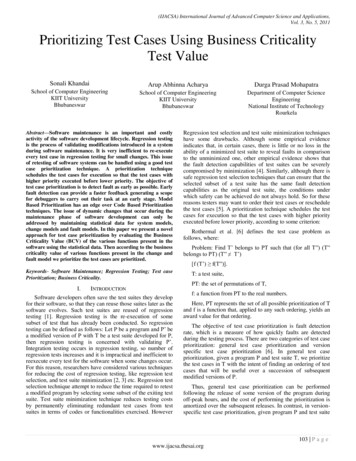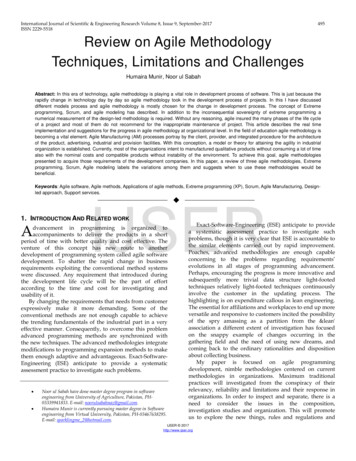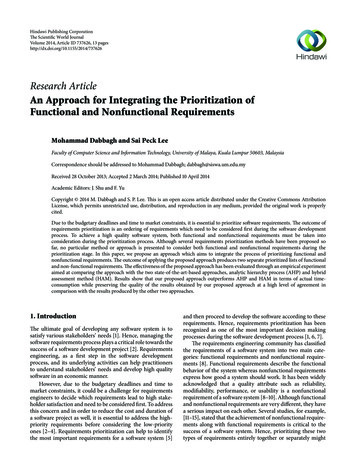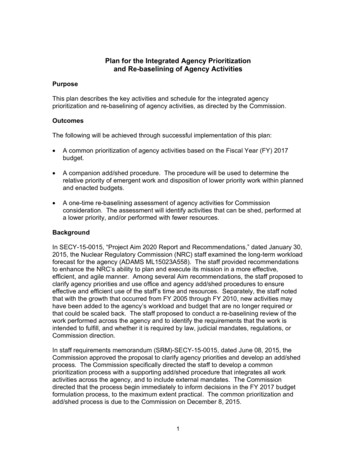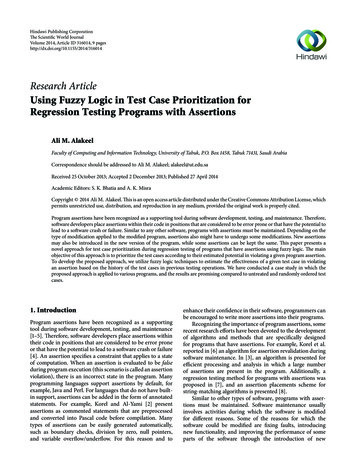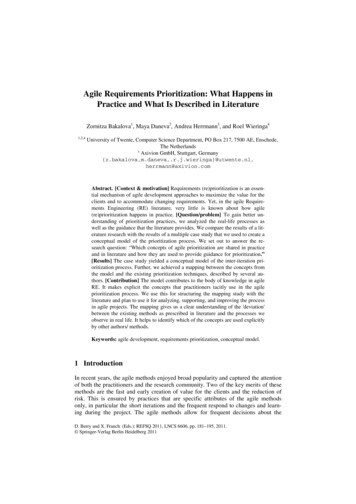
Transcription
Agile Requirements Prioritization: What Happens inPractice and What Is Described in LiteratureZornitza Bakalova1, Maya Daneva2, Andrea Herrmann3, and Roel Wieringa41,2,4University of Twente, Computer Science Department, PO Box 217, 7500 AE, Enschede,The Netherlands3Axivion GmbH, Stuttgart, .nl,herrmann@axivion.comAbstract. [Context & motivation] Requirements (re)prioritization is an essential mechanism of agile development approaches to maximize the value for theclients and to accommodate changing requirements. Yet, in the agile Requirements Engineering (RE) literature, very little is known about how agile(re)prioritization happens in practice. [Question/problem] To gain better understanding of prioritization practices, we analyzed the real-life processes aswell as the guidance that the literature provides. We compare the results of a literature research with the results of a multiple case study that we used to create aconceptual model of the prioritization process. We set out to answer the research question: “Which concepts of agile prioritization are shared in practiceand in literature and how they are used to provide guidance for prioritization.”[Results] The case study yielded a conceptual model of the inter-iteration prioritization process. Further, we achieved a mapping between the concepts fromthe model and the existing prioritization techniques, described by several authors. [Contribution] The model contributes to the body of knowledge in agileRE. It makes explicit the concepts that practitioners tacitly use in the agileprioritization process. We use this for structuring the mapping study with theliterature and plan to use it for analyzing, supporting, and improving the processin agile projects. The mapping gives us a clear understanding of the 'deviation'between the existing methods as prescribed in literature and the processes weobserve in real life. It helps to identify which of the concepts are used explicitlyby other authors/ methods.Keywords: agile development, requirements prioritization, conceptual model.1 IntroductionIn recent years, the agile methods enjoyed broad popularity and captured the attentionof both the practitioners and the research community. Two of the key merits of thesemethods are the fast and early creation of value for the clients and the reduction ofrisk. This is ensured by practices that are specific attributes of the agile methodsonly, in particular the short iterations and the frequent respond to changes and learning during the project. The agile methods allow for frequent decisions about theD. Berry and X. Franch (Eds.): REFSQ 2011, LNCS 6606, pp. 181–195, 2011. Springer-Verlag Berlin Heidelberg 2011
182Z. Bakalova et al.requirements that will be considered for implementation at each iteration and in practice this is implemented by the process of requirements re-prioritization. As Gottesdiener [11] puts it: “Each release represents the culmination of a series of requirementsdecisions.” The highest priority features (i.e. requirements in agile terminology) getimplemented early so that most business value gets realized, while exposing the project to as low a risk as possible. As the agile literature agrees upon, e.g. [3],[6],[13], akey tenet of agile processes is that the requirements are prioritized by a customer,customer team, or ‘product owner’ acting as a proxy for the end users of the intendedsystem. The rationale behind this is that the client is the one who can make a judgment about the value of each requirement. Nevertheless, researchers [5], [16] in agileRE case studies found that the creation of software product value through requirements prioritization decision-making is only partly understood.This paper presents a piece of work that is part of a series of studies about agile requirements prioritization. It builds upon our earlier publications [18],[20] in which weinvestigated the agile requirements prioritization (RP) process as described in literature [18], and as it happens in real-life projects [20]. This research now comparesliterature to practice and investigates and compares how complete and how detailedagile software engineering literature describes requirements reprioritization. This is aknowledge problem [26] aimed to identify the gap between practice and literature. Wemake the note that the key differences between our earlier work [18], [20] and thisone consists in establishing the explicit mapping between the literature and the practice and in reasoning about its implications for research and practice.This paper sets out to answer the following research question (RQ): “Which concepts of agile prioritization are shared in practice and in literature and how they areused to provide guidance for prioritization.” We answer it by mapping existing agileprioritization techniques to findings from a case study. In this paper we (i) firstpresent a generic model derived from the case study and describe the conceptual categories that appear in it, and (ii) perform the mapping between these categories andexisting techniques from literature, which is the main contribution of the paper.This research represents a further step to contribute to the understanding of agilerequirements reprioritization at inter-iteration time, and to assess the guidance thedifferent RP methods provide. As per Alenljung and Person [2], a decision-makingsituation is “a contextual whole of related aspects that concerns a decision-maker”,that is – in our case, the client or the product owner in an agile project.The paper is structured as follows: Sect. 2 presents our motivation, Sect. 3 introducesthe research method and Sect. 4 describes the results of its application. Sect. 5 discussesthe results, Sect. 6 is dedicated to validity threats, and Sect.7 concludes the paper.2 MotivationThe practices of regular RP, with strong client participation, are a relatively recentphenomenon. In turn, they are only partially understood. Furthermore, the RP is anessential mechanism to maximize the business value (BV) for the clients and to accommodate changing requirements. We make the note that our previous study on BVcreation brought us to think that we can not expect one universal definition of BV. Incontrast, the notion of BV varies across projects and organizations, depending on
Agile Requirements Prioritization183(i) the different project-specific settings, (ii) the specific needs of the client (for example, the need to have highly reusable or highly scalable software), and (iii) themarket position of the client’s organization. It comes out of a human judgment that isbased on competencies and deep knowledge of the client’s domain and needs. For thisreason, for the purpose of this study under BV we understand the client’s perceivedvalue of a requirement.The reasoning in the previous paragraph motivated us for studying the agile RPprocess as it happens in real life and as described in literature. Moreover, we alsomade the observation that the agile literature [12],[13],[22] provides rather coarsegrained descriptions of the agile reprioritization process only [20], the literature is notcomplete and the RP methods are not described in such detail that a practicing software engineer can take them and immediately use them in his/her work. For example,we searched literature for specific information on how the process of value creationtakes place in an agile project [17] and we could find no source that indicates howexactly this happens. In this work we investigate the guidance that the different RPmethods described in literature provide to the decision-makers, by comparing literature sources with each other. We do this by using the concepts of our conceptualmodel as the common ground for our comparison. From this mapping and comparison, we can learn how complete and detailed is the published guidance.Agile literature sources suggest, e.g. in [4], that never before in the software engineering history the customer has been that actively involved in the requirementsreprioritization as he/she is in agile. However, our case study [19] indicates that inmany cases the developers or their representative (e.g. a product owner), are activelyinvolved and more often than not are leading the inter-iteration decision-making process, keeping in mind the value-creation for the clients. That’s why we felt motivatedto study the decision-making - as perceived by the developers, with client’s goals inmind. Given this backdrop, we think that more clarity is needed in respect to: What dothe decision-makers need to consider in order to create more value for the clients /stakeholders? Thus, a decision-maker would profit from a clear model of the prioritization process available to him/her. We think that a conceptual model can help thedecision-maker (e.g. the client) in at least three ways: (i) to navigate through the agileprocess of delivering business value; (ii) to make explicit the tacit assumptions indifferent RP methods; (iii) to identify those possible pieces/sources of informationimportant to the outcome of the prioritization and, consequently, to the project.We also think that our model would help those RE researchers who are interestedin carrying out empirical research to investigate how agile requirements decisionmaking happens in practice, to structure research questions and empirical data. Thegoal of this study is to identify which concepts of agile prioritization are shared inpractice and in literature, and to understand if there is a gap between the guidance forprioritization that literature provides to practitioners, and the prioritization process asobserved in a case study. This result is meant to help to: (i) map different techniquesand concepts to each other; (ii) analyze the level of guidance the different methoddescriptions provide to practitioners (in terms of those concepts that are explicitlyused). (iii) be used as a framework for structuring the discussion about requirementpriorities in an agile project and thus lead to explicit and better motivated requirements choices.
184Z. Bakalova et al.3 The Research MethodIn this section we provide a description of the case study that yielded the conceptualmodel. First, we conducted an explorative multiple-case study, applying the Yin’sguidelines [27]. It included semi-structured open-end in-depth interviews with practitioners from 8 agile software development organizations. Second, we mapped theexisting prioritization techniques to the categories identified in the case study.3.1 The Case Study Process and ParticipantsOur case study is performed in the following steps: (1) Compose a questionnaire; (2)Validate the questionnaire through an experienced researcher; (3) Implement changes inthe questionnaire based on the feedback; (4) Do a pilot interview to check the applicability of the questionnaire to real-life context; (5) Carry out semi-structured interviewswith practitioners according to the finalized questionnaire; (6) Sample and follow-upwith those participants that possess deeper knowledge or a specific perspective.The case companies characterized themselves as organizations that follow agilemethodologies. Some of them did strictly follow Scrum principles such as daily stand–up meetings and release retrospective. Most of them, though, applied a combination ofagile practices without sticking precisely to a specific agile software development orproject management approach.Each interview lasted 60 to 90 minutes. Each interviewee was provided beforehandwith information on the research purpose and the research process. At the interviewmeeting, the researcher and the interviewee walked through the questionnairewhich served to guide the interviews. The questionnaire consisted of three parts:(i) questions referring to the prioritization practice in one concrete project; (ii) questions about the general prioritization practice in the company, based on the interviewees’ experience; and (iii) questions about the role of value-consideration for(re)prioritization. Examples of the questions asked are: “Who performs the prioritization?”, “What criteria do you consider?”. The study included 11 practitioners whodescribed a total of ten projects (two practitioners worked on the same project holdingdifferent roles). The application domains for which these practitioners developedsoftware solutions represent a rich mix of fields including banking, health care management, automotive industry, content management, online municipality services, andERP for small businesses. The information about the participating companies andspecialists is summarized below: 1 middle size company in the Netherlands (2 cases, 3 participants)2 small companies in the Netherlands (3 cases, 3 participants)1 small company in Bulgaria (1 participant)1 middle size company in Bulgaria (1 participant)1 German university (1 student project)1 large consultancy in Italy (1 participant)1 IT department in a large governmental organization in Turkey (1 participant)Table 1 explains the primary role the case-study participants had in the studiedprojects.
Agile Requirements Prioritization185Table 1. Participants in the InterviewsInterviewee’s primary roleProject ManagerDeveloperProduct OwnerClientScrum MasterTotal Number of Interviewees3.2Number of interviewees5311111The Data Analysis StrategyIn our case study, the data analysis was guided by the Grounded Theory (GT) methodaccording to Charmaz [7]. It is a qualitative approach applied broadly in socialsciences to construct general propositions (called a “theory” in this approach) fromverbal data. GT is exploratory and well suited for situations where the researcher doesnot have pre-conceived ideas, and instead is driven by the desire to capture all facetsof the collected data and to allow the theory to emerge from the data. In essence, thiswas a process of making analytic sense of the interview data by means of coding andconstant comparison of pieces of data that were collected in the case study. Constantcomparison means that the data from an interview is constantly compared to the dataalready collected from previously held interviews, until a point of saturation isreached, i.e., where new sources of data don’t lead to a change in the emerging theory(or conceptual model).We first read the interview transcripts and attached a coding word to a portion ofthe text – a phrase or a paragraph. The ‘codes’ were selected to reflect the meaning ofthe respective portion of the interview text to a specific part of the RQ. This could bea concept (e.g. ‘value’, ‘method’), or an activity (e.g. ‘estimation’). We clustered allpieces of text that relate to the same code in order to analyze it in a consistent andsystematic way. The results of the data analysis are presented in Fig. 1 and discussedin Section 5.4 Results4.1 The Conceptual ModelThis section builds upon our previous work [18], where a preliminary result of our GTprocess has been presented. Here, we draw on this early result, extend it, elaborate more in detail, the concepts involved, and discuss how we use the conceptual modelto analyze the prioritization methods (Sect. 5.2).Our multiple iterations of coding, constant comparing of information from the interviews, and conceptual modeling in our GT process yielded the model presented inFig 1. Its purpose is to explicate and bring insights into the decision-making, which isthe core of the RP process. The model takes the perspective of the client, unlike otherRP authors [4],[9],[12] adopting the perspective of the developers. This model is tohelp clients ‘zoom-in’ into the prioritization process and see those concepts which areimportant to consider in RP at inter-iteration time, including context. It describes whathappens in all those RP processes about which we learnt from the participants in the
186Z. Bakalova et al.case study. In the model we take a generic perspective of RP, that is, it abstracts fromthe use of a specific RP approach.Our case study results suggest that there is a consensus among the practitioners thatthere are seven aspects that the clients consider when making decisions on requirements priorities: Project Context, Prioritization criteria, Effort Estimation/ Size Measurement, Learning Experience, Input from the developers, Dependencies and ExternalChange. Iteration planning additionally considers Project Constraints. Below we explain each of these conceptual categories, and their impact on the RP process.1. During the case study, we observed that the prioritization process itself varies significantly in terms of participants involved, prioritization criteria applied, purposeand frequency of the prioritization. The interviewees shared that, in their view, thevariation depends to large extent on the context of the project. We represented thisvariability in the model by the concept ‘Project Context’. It includes those projectsettings such as ‘size of the project’ or ‘size of the client’s organization’, and is usedto explicate the impact of these settings on the prioritization process. In the projects ofour practitioners, the concrete instantiations of the prioritization processes weredeemed to be linked with these contextual settings. For example, our intervieweesobserved that in projects with similar contexts, the instantiated prioritization processesare similar in respect to who are the decision-makers and the amount of participationof the different parties in the process.2. All interviewees agreed on that the project context has a significant impact on the‘Prioritization Criteria’. We observed also that they all consider the Business Valuethe dominating RP criterion, whereby Business Value is estimated by the customeralone. In some projects we observed one recurring question being asked at requirements reprioritization time: “Is a requirement absolutely necessary to support themain usage scenario?” This question implies a notion of ‘damage to the client’ or‘negative value to the client’ in the case the requirement is not implemented. Wetermed this criterion ‘Negative value’. One study participant said: “All features thatbelong to the main usage scenario were considered mandatory and needed to beincluded in the product. This drove the decision-making process.“ In addition to Business Value, the client in some projects considers the Risk caused by a requirement’simplementation.3. In the experience of the interviewees, the client considers ‘Estimated Size’ basedon functional size when making decisions on priorities. The estimation of Size/ Effortimpacts the value estimation as well. For example, a participant put it this way “If wegive a high estimation for certain requirement (in terms of time /cost), it happensthat the client starts considering this requirement as less important as previouslythought.” We make the note that size, effort, cost and risk are estimated by the developers and provided to the clients for their decision-making. From the client’s perspective, size is a given – though potentially uncertain – input.4. Another ‘building block’ in the RP process appeared to be the developer’s perspective (box ‘Input from the Developer’ in Fig. 1). While the literature [3] deems therole of the developers for the RP process secondary, the case study revealed a different situation. In the majority of the cases the developers were the more influentialparty, providing advice and alternative solutions, but also taking into considerations
Agile Requirements Prioritization187the interests of their own organization (such as ‘possible reuse of the requirement’,‘importance of the project for the organization’, ‘available resources at the moment’).5. The conceptual category ‘External Change’ stands for those events that happenduring the project and impact the company, the business environment or the productunder development. Such changes can impact the value of requirements. The interviewees deemed the external changes be one of the reasons for clients’ requirementschange requests.6. The category ‘Learning Experiences’ represents new insights acquired by both theclients and the developers during the project, such as new knowledge about technicalsolutions, or new insights about the desired functionality of the product under development. They impact the value estimation, the prioritization decisions and the sizeestimation. For example, while working in a project that we investigated, the developer learned about the exact functionality of open-source software that he intended touse. This new insight triggered changes in the initial estimations and thus in the priorities of the requirements. Learning is an in-built principle in agile development.Harris and Cohn [13] advise “Incorporate new learning often, in order to decide whatto do next”.Fig. 1. Conceptual model of the agile prioritization process7. The ‘Project Constraints’ such as duration, release date, budget, velocity andavailable resources, impact both the prioritization decisions and the iteration planning.8. ‘Dependencies’ between requirements can be of different nature – e.g. chronological or architectural dependencies. Both clients and developers express the dependencies that have to be considered, from their perspective.9. The ‘Project Backlog’ means the list with requirements for the projects. PrioritizedProject Backlog is the ordered list of requirements, and a sub-set of it (called iteration,and in some agile methods - sprint backlog) is to be implemented in the next iteration.
188Z. Bakalova et al.‘Prioritized’ means to assign a requirement a priority, which during iteration planningtranslates into an order of implementation: i.e. starting with the requirements with thehighest priority, so many requirements are chosen for the iteration backlog as can beimplemented within the next iteration and project constraints.We make the following notes: First, we note that the iteration planning and thebacklog of the follow-up iteration (i.e. the sprint backlog in the terms of some agileapproaches), is out of the scope of this paper and is shown on the model for sake ofcompleteness only. Second, we also note that in Fig 1, arrows reflect relationshipsbetween the concepts. For example, the ‘learning experience’ impacts the size/effortestimation. This is so because with the progress of a project the developers learn tobetter estimate both the amount of work they are able to perform in one iteration, aswell the concrete effort (in hours), or the size of a requirement (e.g. in story points).The learning also is about the mapping factor of story points to effort in hours/ days.This leads to more correct estimations for the following iterations. We make the note,however, that the discussion on the nature of the relationships and the completeness ofthe set of relationships is outside the scope of this paper. Third, we traced the conceptsback to the interview questions that we asked and the interview answers we collected.Because of space limitation, we do not provide information on this in this paper. However, we provide an illustration of this process by using the concept ‘Negative value’.This concept originated from two questions: “Which factors played a role during thedecision making?” and “Do you use explicit criteria for the prioritization?” Theconcept was derived based on the following statements of our interviewees “We considered how big the damage will be if a requirement is not implemented. We call this‘negative value’, “Is a requirement absolutely necessary to support the main usagescenario?”, and “How angry will the client be if certain feature is missing.”As indicated earlier, the resulting model is compatible with any RP technique. Itdoes not prescribe any process or propose a new technique, but instead just describeswhat we found in the case study. This means that a decision-maker could use this conceptual model as a framework for reasoning about his/her RP process independently ofhis/her concrete context. Clearly, not all of the elements in the model are necessarilypresent in each RP process – i.e. some of them depend on the project context. For example, one can use the concepts of the model to depict a specific client’s RP situationin a specific project, in a specific organization and, thus, take into account the topicsimportant for clients to consider in RP at inter-iteration time. The model’s completeness still should be validated empirically, e.g. by new case studies.4.2 Mapping of the Existing Agile Prioritization Methods on the ModelIn our previous work [20] we identified from the literature 22 prioritization techniquesthat are being used in agile context. Here we don’t provide motivation for the choice ofthe literature and references to the sources where the techniques are described, as thishas been already discussed in [20]. We, therefore, suggest interested readers either lookinto the [20], or contact the authors for receiving the complete list with references.In this section we perform a mapping between the conceptual categories of themodel in Fig. 1, and their presence in the existing prioritization methods. By means ofthis mapping, we will see which of the conceptual categories (that we discerned in thecase study and that constitute the model) are in fact used by other authors and techniques. The mapping is performed by reading the descriptions of the methods and
Agile Requirements Prioritization189identifying those concepts that correspond to the ones in our model (Fig. 1). The result is presented in Table 2. Therein, the first column presents the 22 RP techniques.The other columns are named after the categories in the conceptual model in Fig. 1. Arow in the table is to indicate those concepts that a particular technique supports anddoes this up to a certain extent, i.e. the concept appears explicitly in the description ofthe technique. In the table, we populate the cells with the symbols ‘y’ to mean thoseRP method in the description of which we observe that the corresponding concept hasbeen stated and used explicitly. Furthermore, in addition to the concepts that appear inthe model, we have added an additional column S in Table 2 to acknowledge that adescription of a method indicates the use of tacit knowledge in the requirements prioritization. In this column, we place in the symbol ‘x’ to mean those methods wherewe identified that the decisions are made based on implicit, subjective opinion of thedecision-maker (“intuitive prioritization”). We make the note that the empty cells inTable 2 mean that we could not find explicit indication about the use of the concept.For example, the second row is about the method Ping Pong Balls. From the description we discern that this technique uses value and risk as prioritization criteria (‘y’ inthe first cell), the context of suitability of the methods is described (‘y’ in the secondcell), and cost is considered as well. We proceeded analogically with all methods andconcepts. We make the note that most of the techniques are not described in the literature in great detail. Further, they don’t discuss explicitly what concepts drive the prioritization decision. For example, the ‘Round-the-group’ prioritization, and the ‘PingPong Balls’, take the subjective judgment of each participant as an input into the decision-making process, without discussing why each participant estimates one requirement (or feature) to be of higher priority than another. The majority of the descriptionsof the techniques are focused on the steps that transform an initial list of requirementsinto a prioritized list, i.e. in which order they shall be executed, and say almost nothingabout the considerations used to determine the priority order itself. For example, Gottesdiener [12] says about the Pair-wise analysis: “You successively rank requirementsby comparing them in pairs until the top requirements emerge at the top of the stack.”However, we found that there are almost no methods, described in the literature,that explicitly state the criteria on which the decisions are based and the influence ofthe context. Nor there is indication about who is or should be involved in the decision-making process. We think that a possible reason for this finding could be thenature of the agile decision-making itself, where the team is empowered and selforganized and where team members’ tacit knowledge plays a significant role. Further,our observations indicate that some of the methods don’t strive for perfection in thesense that their authors mean them to be universally useful. Instead, these methods arejust ‘good enough’ for certain application contexts. Wiegers [25] is one of the veryfew who explicitly states the criteria used and that these criteria he uses in his approach are not the only one that play a role during prioritization. For this reason hewarns practitioners that the scheme he proposes should not be considered as the onlymethod to set priorities. Moreover, he advises to use this approach to decide about‘negotiable’ features only, i.e. the ones that are not in the top-priority category. Thecore features shall be included anyway.Another reason for the low level of detail of the methods described in literaturemight be that the practitioners who are authors of the compared methods consider that
190Z. Bakalova et al.it requires only common sense to execute the prioritization, and they trust the team todo it right without much guidance.Furthermore, in Table 2 we observe that:1. Learning is treated explicitly only by Extreme Programming (XP). Thisobservation is surprising, given the fact that many authors deem the explicit use oflearning between two iterations the main advantage of the agile paradigm [9],[13] weassume this is incorporated rather implicitly in the methods, by means of their iterative nature and frequent decision-making cycles.2. External change – although an important aspect in agile developmen
prioritization that literature provides to practitioners, and the prioritization process as observed in a case study. This result is meant to help to: (i) map different techniques . priorities in an agile project and thus lead to explicit and better motivated require-ments choices. 184 Z. Bakalova et al. 3 The Research Method
